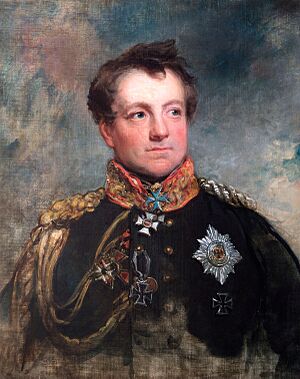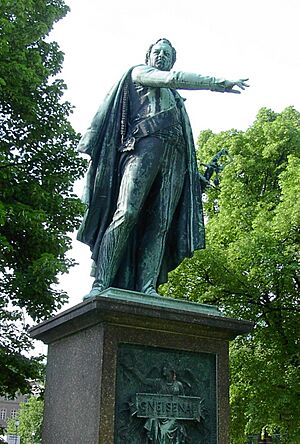August Neidhardt von Gneisenau facts for kids
Quick facts for kids
Count August Neidhardt von Gneisenau
|
|
|---|---|

Gneisenau by George Dawe, 1818
|
|
| Born | 27 October 1760 Schildau, Electorate of Saxony, Holy Roman Empire |
| Died | 23 August 1831 (aged 70)
|
| Allegiance | |
| Years of service | 1779–1831 |
| Rank | Generalfeldmarschall |
| Commands held | VIII Prussian Corps |
| Battles/wars | |
| Awards |
|
| Signature | |
August Wilhelm Antonius Graf Neidhardt von Gneisenau (October 27, 1760 – August 23, 1831) was a very important Prussian field marshal. He played a big part in changing the Prussian military and helped lead the fight against Napoleon during the Wars of Liberation.
Contents
Early Life and Military Start
Gneisenau was born in Schildau, which was part of Saxony at the time. His family was not wealthy. In 1777, he started studying at the University of Erfurt.
Two years later, he joined an Austrian army regiment. In 1782, he added "Gneisenau" to his name, honoring some old family lands. He then became an officer in the army of Bayreuth-Ansbach.
Serving in America
Gneisenau gained valuable experience by serving in the American Revolutionary War. He was part of a German regiment that was hired by the British. After returning in 1786, he joined the Prussian army. King Frederick the Great made him a first lieutenant in the infantry.
In 1790, he became a staff captain. He served in Poland from 1793 to 1794. For the next ten years, he was stationed in Jauer. This quiet time allowed him to study military history and politics deeply. In 1796, he married Caroline von Kottwitz.
Fighting in the Napoleonic Wars
In 1806, Gneisenau served as a staff officer for Prince Hohenlohe. He fought in the battles of Saalfeld and Jena. Later, he led an infantry group in the campaign in Lithuania.
Defending Kolberg
In 1807, Major von Gneisenau was put in charge of Kolberg. This town was small and not well protected. However, with help from others, Gneisenau successfully defended Kolberg against Napoleon's forces. They held out until the Peace of Tilsit was signed in July 1807. For his bravery, Gneisenau received the important Pour le Mérite award and was promoted to lieutenant-colonel.
Reforming the Army
After Kolberg, Gneisenau took on a bigger role. He became the chief of engineers and helped rebuild the Prussian army. He worked closely with Scharnhorst on these important military changes. He also influenced the overall plans of the Prussian War Ministry.
In 1809, he became a colonel. His strong actions made the French suspicious, and he had to retire for a short time. But he traveled to Austria, Russia, Sweden, and England on secret missions. He then returned to Berlin and continued to lead the group of people who wanted to free Prussia from French control.
Working with Blücher
When the Wars of Liberation began in 1812, Major-General Gneisenau became Blücher's quartermaster-general. This meant he was Blücher's chief of staff, helping to plan and organize the army.
Their partnership was one of the best in military history. Blücher was a brave commander, and Gneisenau was a brilliant planner. Together, they led the Prussian troops. Even when they faced defeats, they never gave up. They fought their way into the heart of France.
March to Paris
In 1814, Gneisenau created the plan for the march on Paris. This plan directly led to Napoleon giving up his power in April 1814. As a reward for his excellent service, Gneisenau was made a count.
Waterloo Campaign
In 1815, Gneisenau was again Blücher's chief of staff during the Waterloo campaign. He played a very important role. When Blücher was injured at the Battle of Ligny on June 16, 1815, Gneisenau took command of the Prussian army.
He gathered the army and led them towards Wavre. From there, part of the army marched to join Wellington at the Battle of Waterloo on June 18, 1815. The Prussian attack from the side helped Wellington's army win the battle.
After Waterloo, Gneisenau led the chase of Napoleon's forces. This led to the capture of Napoleon's carriage. Gneisenau also made sure the Prussian forces reached Paris before Wellington. For his achievements, Gneisenau was promoted again and received the Prussian Order of the Black Eagle.
Later Life and Legacy
In 1816, Gneisenau was given command of the VIII Prussian Corps. However, he soon retired due to health issues and political reasons.
For two years, Gneisenau lived quietly at his estate in Silesia. But in 1818, he became the governor of Berlin and a member of the Council of State. In 1825, he was promoted to general field marshal.
In 1831, after the Polish uprising began, he was put in charge of the army watching the Polish border. Clausewitz was his chief of staff. While in Posen, Gneisenau became sick with cholera and died on August 24, 1831. His chief of staff, Clausewitz, also died from the same disease a few months later.
Honours
Gneisenau received many awards and decorations for his service:
 Kingdom of Prussia:
Kingdom of Prussia:
- Pour le Mérite, August 17, 1807; with Oak Leaves, March 31, 1814
- Iron Cross, 1st and 2nd Class, 1813
- Knight of the Black Eagle, June 28, 1815
- Knight of the Red Eagle, 1st Class, June 28, 1815
- Service Award Cross
 Austrian Empire:
Austrian Empire:
- Commander of the Military Order of Maria Theresa
- Commander of the Imperial Order of Leopold
 Kingdom of Bavaria: Grand Cross of the Military Order of Max Joseph, February 27, 1814
Kingdom of Bavaria: Grand Cross of the Military Order of Max Joseph, February 27, 1814 Kingdom of Hanover: Grand Cross of the Royal Guelphic Order, 1827
Kingdom of Hanover: Grand Cross of the Royal Guelphic Order, 1827 Netherlands: Grand Cross of the Military William Order, July 8, 1815
Netherlands: Grand Cross of the Military William Order, July 8, 1815 Russian Empire:
Russian Empire:
- Knight of St. George, 3rd Class, August 25, 1813
- Knight of St. Alexander Nevsky, October 8, 1813
- Knight of St. Vladimir, 2nd Class, December 10, 1813
- Knight of St. Anna, 1st Class
- Sword of Honour "for Bravery"
- Knight of St. Andrew, May 26, 1829
Lasting Impact

Gneisenau's legacy lives on in many ways.
- A statue of him was put up in Berlin in 1855.
- A grenadier regiment (a type of soldier unit) was named after him in 1889, remembering his defense of Kolberg.
- One of his sons led a brigade in the Franco-Prussian War in 1870.
- A painting of him by Marie von Brühl is in the Deutsches Historisches Museum.
- One of the four major attacks by Germany in 1918 during World War I was named after him.
- Several German navy ships have been named Gneisenau, including a World War I armored cruiser and a famous World War II battleship.
- Many cities in Germany have streets named "Gneisenaustraße" (Gneisenau Street), including Berlin, Leipzig, Hamburg, Hanover, and Heidelberg. Berlin even has a subway stop named after him.

